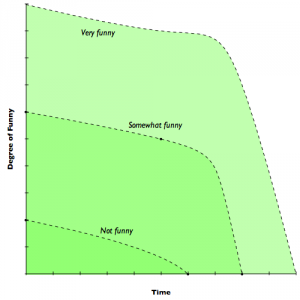A short story that’s mildly funny is much funnier than a long story that is mildly funny.
Note: funny / interesting can be interchanged.
Introduction:
Why are knock-knock jokes so funny? Well they may not be THAT funny, but the fact that they’re short makes them more tolerable. However, a funny story, told over a long period of time, rapidly loses its appeal. This is where the Funny-ness to Length of story index (F2LOSi) comes in.
Description of the Indicator:
The F2LOSi measures the relationship between how funny a story is and the length of that story. Understanding this metric requires an honest self-assesment of how good someone is at telling stories, and also how good they are at picking stories in the context of a conversation. Funny-ness is measured on a global scale, where the story, as a whole, is evaluated for how funny it is. Stories with an extraordinary punch line, fare better than stories with a constant trickle of funny-ness as punch line can actually make a long story funnier than a long story with an even does of funny. Time, well… that’s quite simple… It’s minutes, or seconds, or “short” vs. “long”.
How to read it:
Quite linearly, if you don’t start with a very good story, you have little time to make it to the end. For really funny stories, there is a chance that the story can remain long, however at a certain point (this changes for every story), the story becomes unfunny quite rapidly.
Usage:
Thanks Jim… The F2LOSi on that one was quite low…Stop interrupting me. The F2LOSi on this story is gradually getting worse.
Notes:
1 – F2LOSi is rarely perceived on high and moderate values, but is almost always noticed on low values.
2 – F2LOSi can only be measured after the fact by others, or during the telling of the story by the narrator.
